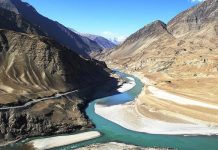India is faced with a new challenge from China, hungry for expanding its influence in South Asia and the surrounding areas. India’s pledge for $500 million investment to develop Iran’s strategically and economically significant Chabahar port is going to be overshadowed with China, on invitation from Iran, likely to express its readiness to associate itself in a big way with the project. China’s CITIC Group, a state-owned investment agency, recently offered Iran a $10 billion credit line and the China Development Bank is in the process of providing $15 billion additional funds to Teheran. A part of Beijing’s $124 billion Belt and Road initiative, this is, perhaps, the largest investment commitment by any foreign country in the Persian Gulf nation, freed from crippling economic sanctions in 2015 following a nuclear deal with the US and its European allies.
Though Iran has declared that its offer to China and Pakistan to provide all kinds of assistance for developing Chabahar to bring it to the level of Pakistan’s Gwadar port will not affect India’s association with this project, New Delhi cannot accept the development without concern. It is almost certain that cash-rich China may try to dominate Chabahar through a huge investment in the project to primarily belittle India’s gain. Iran too will welcome Chinese investment in the port project to any extent as it wishes to see it emerge as a major port as Pakistan’s Gwadar, developed exclusively by the Chinese. The distance between the two ports is hardly 72 km.
China, aiding Iran in the development of different kinds of infrastructural facilities like highways, railways and power projects, is set to outshine European Union (EU) nations and Russia in making investments in Iran. It suits Iran too to have increased investment presence from China, Russia, the EU or any other country to create a kind of shield to protect it from adventurist military campaigns by the US or its allies like Israel.
According to the chief of Iran’s Organization for Investment, Economic and Technical Assistance, Mohammad Khazaie, direct investments in Iran by Chinese companies rose by 20 per cent during the period March 2014-January 2018. The trade volume between the two countries, which grew by 22 per cent in 2017, is expected to go up to $50 billion in 2018 from $40 billion in 2017.
Iran, however, says, “The priority is with the Indians — they’ve been involved and came forward first (2003). But if another investor comes along and is interested in Chabahar, there is certainly enough space and opportunity for them and for their investment.” Obviously, Iran has invited China after making considerable calculations as it has given hints that it does not want Chabahar-linked cooperation remaining limited to India.
Though India has invested in developing two terminals at the port which have become operational and are being used for the supply of different kinds of items to Afghanistan and Central Asian countries, New Delhi and Teheran have been involved in issues like a two-year-old dispute over whether India would pay $30 million of excise duties on port equipment imported into Iran. There have also allegedly been investment-related delays even after 2015, when most of the sanctions imposed on Iran were lifted, but not without reason. India will have to keep its own interests in view while taking any step to cement its ties with Teheran.
Of course, it is Iran’s “prerogative” to choose its partners, but India’s interests should not be allowed to be affected under all circumstances. Will Teheran be able to ensure it? Whatever Iran may claim, China can be expected to use every tactic it can think of to create problems for India in the region and beyond.
China’s entry into Chabahar will not be only for trade purposes. Experts believe that Beijing will not hesitate to use the Iranian port for surveillance purposes as it will do from Pakistan’s Gwadar port and those which have come up with Chinese financial assistance in Myanmar, Bangladesh and Sri Lanka. In fact, it is believed that China may find a way to have its military presence in all these ports, a very disturbing development, indeed, for India.
India will have to prepare itself to meet the Chinese threat through these ports as also from the China-Pakistan Economic Corridor (CPEC), which is going to be extended to Afghanistan. New Delhi will have to convince Afghanistan that Chinese increased presence in the war-torn country may help Pakistan to keep troubling Kabul through Islamabad’s Taliban proxies so long as Afghanistan refuses itself to be used by Pakistan for the latter’s strategic interests.
It must be mentioned here that India has been protesting against the CPEC idea as it passes through Pakistan-held Kashmir. The US growing interests in India to counter Chinese expansionist designs particularly in Asia can come handy to New Delhi to create insurmountable roadblocks for China in Afghanistan, though not an easy task. But the US will have to be more forthcoming to side with India to protect New Delhi’s strategic and other interests in Kabul.
The significance of Iran for India’s interests in Afghanistan and Central Asian republics cannot be underestimated.India will have to ignore US pressure tactics not to go as closer to Teheran as the situation demands. For India, proximity to both Washington and Teheran will have to be maintained intelligently to send across the message that India under all kinds of circumstances will not allow its interests to be compromised.
India may face trouble in the case of Iran if the US withdraws itself from the 2015 nuclear deal with Teheran and involving other Western powers. Iran has been warning the world community that if the US indulges in this irresponsible behaviour and withdraws itself from the nuclear deal, though aimed at capping Teheran’s nuclear power facilities, there may be the possibility of an exchange of hot words getting revived between the US and Teheran. In such a scenario, if it emerges all, India will have to tread the path with a lot of caution.
Since Teheran is also involved in the West Asian war theatre and fighting against Sunni Arab countries like Saudi Arabia in Syria, it would be a major diplomatic challenge for India to protect its interests by maintaining friendly relations with both camps. New Delhi, therefore, cannot side openly with any of the countries involved in the civil war in Syria and the rest of West Asia.
letters@tehelka.com













